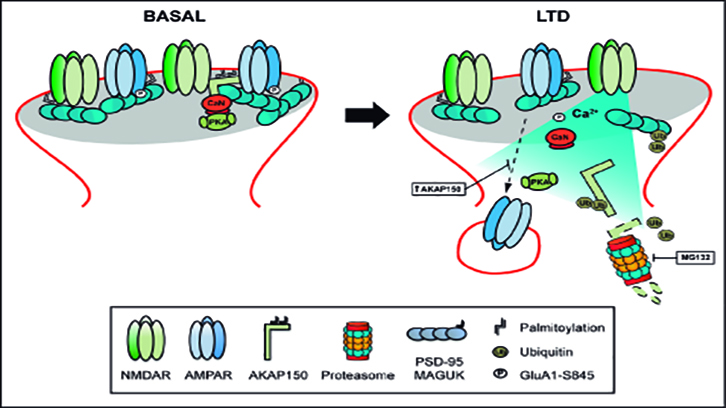Degradation of scaffold protein is related to the reduction of synaptic glutamatergic AMPA receptors

In our last publication, in eNeuro journal, we demonstrated the importance of the scaffold protein AKAP150 degradation in the regulation of AMPA-glutamate receptors associated with synaptic plasticity. This research will allow knowing better this protein and opening the possibility to use it as a therapeutic target in brain pathologies that present deregulation in synaptic AMPA receptors.
Synaptic receptors, surrounded by scaffold proteins, play a fundamental role in synaptic plasticity processes underlying learning and memory that occur in the hippocampus. During these processes, the receptors quantity creases or decreases, controlled by highly orchestrated mechanisms. When receptors appear, the LTP process (long term potentiation) occurs. This allows a lasting increase in synaptic communication between two neurons, increasing synaptic efficacy. In contrast, the LTD process (long term depression) is the opposite phenomenon, where synaptic efficacy is reduced, weakening it and modulating their strength. This process is necessary for synapses to become adequately effective in continuing to process new information.
In this study, published in eNeuro journal, we observed that proteasomal degradation of AKAP150 scaffolding protein is associated with the decrease in synaptic glutamatergic AMPA receptors (glutamate is one of the main excitatory neurotransmitters of the brain) during LTD. By contrast, genetic-mediated restoration of AKAP150 levels is able to prevent it.
The presence of neurotransmitter receptors regulation in the post-synaptic membrane is one of the most important events in synaptic plasticity processes involved in learning and memory that take place in the hippocampus. In recent years, despite efforts to understand the molecular mechanisms associated with these processes, we have still not known in detail which are the key elements. Their knowledge would allow finding new unknown protagonists who would open the door to new therapeutic opportunities.
In the present work, using a LTD cell model, we demonstrated the importance of AKAP150 protein presence in the correct movement of AMPA receptors towards the post-synaptic membrane. Furthermore, the work adds another important advance since it has been possible to identify the relationship between AKAP150 presence and function, and AMPA receptors' presence and transport. This opens the future possibility of intervening in pathologies that have cognitive disorders in common and that present learning and memory disorders where the levels of these receptors are necessary for the normal transmission of the excitatory impulse in the brain.
Institut de Neurociències i Departament de Bioquímica i Biologia Molecular.
Centro de Investigación Biomédica en Red sobre Enfermedades Neurodegenerativas (CIBERNED).
References
Cheng W., Siedlecki-Wullich D., Català-Solsona J., Fábregas C., Fadó R., Casals N., Solé M., Unzeta M., Saura C.A.,Rodríguez-ÁlvarezJ. And Miñano-Molina A.J. Proteasomal-mediated degradation of AKAP150 accompanies AMPAR endocytosis during cLTD. eNeuro 2020; 7(2):1-19. DOI: https://doi.org/10.1523/ENEURO.0218-19.2020


